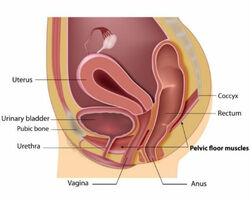Pelvic Floor Dysfunctions (PFD) are characterized as a difficulty or inability to contract (tighten) or relax the muscles that encompass your pelvic floor. The pelvic floor is comprised of a muscular “sling” that forms from your pubic bone to your tail bone. While these pelvic floor muscles are most known for supporting your pelvic organs, they also assist with maintaining proper upright posture, and controlling your bladder, bowel and sexual activity. These muscles typically become overactive or underactive following surgery, post-pregnancy, post cesarean section surgery, chronic low back pain, chronic pelvic pain, bowel and bladder dysfunctions or nerve entrapments, which makes it imperative to assess the entire lumbopelvic complex to rule out any mechanical dysfunctions that could be contributing to your symptoms.
Symptoms of Pelvic Floor Dysfunction can include:
Most females assume that they have to “deal with” these symptoms or that they are natural part of aging. As physical therapists, we are here to tell you that these symptoms are common, but NOT NORMAL! We can provide you with manual interventions to improve external and internal pelvic mobility including trigger point release and myofascial release, provide specific core and pelvic floor stabilization exercises to promote adequate neurological recruitment and eventually progress to balance and plyometric movements with adequate breathing patterns to properly utilize your pelvic floor to reduce the occurrence of incontinence episodes.
Symptoms of Pelvic Floor Dysfunction can include:
- Under or over activity of the bowel and bladder
- Episodes of incontinence with coughing, sneezing or jumping
- Difficulty holding your bowel and bladder for short or long periods of times
- Pain with sexual intercourse (Dysparunia)
Most females assume that they have to “deal with” these symptoms or that they are natural part of aging. As physical therapists, we are here to tell you that these symptoms are common, but NOT NORMAL! We can provide you with manual interventions to improve external and internal pelvic mobility including trigger point release and myofascial release, provide specific core and pelvic floor stabilization exercises to promote adequate neurological recruitment and eventually progress to balance and plyometric movements with adequate breathing patterns to properly utilize your pelvic floor to reduce the occurrence of incontinence episodes.
|
Common Causes of Pelvic Floor Dysfunction:
|

What Diagnoses Do Pelvic Floor Specialists Treat?
How Does Physical Therapy Help With Pelvic Floor Dysfunctions?
At Revolution Rehabilitation our goal is to promote awareness of your pelvic floor contractility by improving core engagement during functional activities, such as lifting up or carrying a child, walking, running and performing higher intensity activities. We also conduct full examinations to rule out or address any pelvic, SI joint or low back mechanical dysfunctions or movement imbalances that could be hindering your pelvic floor contractility and stability. While the complexity of the anatomy of the pelvic floor can make it difficult to diagnose the exact dysfunction, it is imperative that our therapists take a holistic approach with addressing the impairments associated with surrounding musculature of the lumbopelvic complex.
It is our mission at Revolution Rehabilitation is to identify and address the causative factors and empower you with the tools you need to be successful with your treatments.
If you are unsure if you are candidate for Pelvic Floor Physical Therapy, please feel free to contact us at (719) 635-8622 to set up a free 15 minute consultation with our pelvic floor specialist.
- Sexual Dysfunctions
- Levator Ani Syndrome
- Pain with Intercourse
- Difficulty with reaching an orgasm
- Pelvic Pain and Dysfunction
- Pudendal neuralgia
- Vulvodynia
- Vulvar vestibulitis
- Vaginismus
- Pelvic Inflammatory Disease
- Pelvic Congestion
- Disorders with Bowel and Bladder
- Interstitial Cysitis: Inflammation of the bladder
- Irritable Bowel Syndrome
- Feelings of fullness/Constipation
- Mechanical SI Joint, Low back pain, hip pain and Coccydynia
How Does Physical Therapy Help With Pelvic Floor Dysfunctions?
At Revolution Rehabilitation our goal is to promote awareness of your pelvic floor contractility by improving core engagement during functional activities, such as lifting up or carrying a child, walking, running and performing higher intensity activities. We also conduct full examinations to rule out or address any pelvic, SI joint or low back mechanical dysfunctions or movement imbalances that could be hindering your pelvic floor contractility and stability. While the complexity of the anatomy of the pelvic floor can make it difficult to diagnose the exact dysfunction, it is imperative that our therapists take a holistic approach with addressing the impairments associated with surrounding musculature of the lumbopelvic complex.
It is our mission at Revolution Rehabilitation is to identify and address the causative factors and empower you with the tools you need to be successful with your treatments.
If you are unsure if you are candidate for Pelvic Floor Physical Therapy, please feel free to contact us at (719) 635-8622 to set up a free 15 minute consultation with our pelvic floor specialist.



